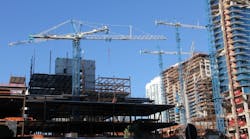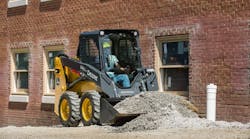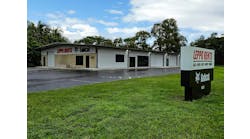Private, Nonresidential Construction Spending Outlook Good, Marcum Finds
The outlook for private nonresidential construction spending remains upbeat, according to the Marcum Commercial Construction Index for the first quarter of 2017.
“Business confidence is in the 97th percentile, unemployment is near a 10-year low, and the Consumer Confidence Index has not been this high since December 2000,” wrote Anirban Basu, Marcum’s chief construction economist and author of the report. “This all bodes well for the U.S. construction sector, which stands to benefit from a combination of consumer and business spending growth.
“Although nonresidential construction spending fell on a monthly basis in March, it remains a largely positive indicator. February’s nonresidential construction spending value of $717 billion… is the highest total since the Census Bureau began tracking the indicator.”
The largest gain was in Communication spending, up 18.5 percent year-over-year in March, to $21.8 billion. Spending in office construction rose 15.7 percent year-over-year to $73.3 billion, followed by commercial construction (+10.9%), amusement & recreation (+9.2%), Lodging (+8.3%), and Power (+4.9%). Public Safety and Educational construction spending closed out the positive results, with gains of 2.5% and 1.0%, respectively.
Of the eight subsectors registering declines, the greatest contraction was in Sewage and Waste Disposal, down 22.3% year-over-year to $19.2 billion. Overall, public sector spending contracted by 6.5%, while private construction spending expanded 6.4% on a monthly basis.
Nonresidential construction employment remained strong, accounting for 3,200 of the 5,000 net new jobs recorded in the construction industry during April, after adding 8,500 in March. Unemployment fell 2.1 percentage points to 6.3 percent.
“The good news is that lower unemployment implies a tighter labor market, which in turn translates into faster wage growth,” Basu added. “However, the lower unemployment rate also means that construction firms will have to work harder to fill available job openings and likely pay more for the workers they hire…The most likely scenario is that the U.S. economy will continue to expand in 2017, that jobs will continue to be created, and that interest rates will rise, but not by enough to completely undermine current housing market or commercial construction momentum or the momentum in the broader economy.”
“It seems that the industry has overcome a weather-related slow start to the year, and we have some great numbers to show for it. Q1 of 2017 has already demonstrated nonresidential spending levels at their highest in the history of that metric, and national unemployment is as low as it has been in the past decade,” said Joseph Natarelli, Marcum’s national construction industry group leader and partner-in-charge of the firm’s New Haven, Conn., office.
For the complete Marcum Commercial Construction Index, visit www.marcumllp.com/industries/construction.









